Corpus-Based Analysis of Synonyms 'Plead' and 'Beg' in English
Abstract
This research is a corpus-based study of the synonyms ‘plead’ and ‘beg’ in the English language. The objectives of the study are to identify appropriate lexical information including connotative meanings, referential implications and the collocations of the selected synonyms, assess the syntactic information involving grammatical patterns of such synonyms, investigate the formality of context and stylistic. The corpus data were obtained from Oxford Advanced Learning Dictionary (OALD), Longman Contemporary English Dictionary (LCED) and Cambridge Advanced Learning Dictionary (CALD). Antconc was used to elicit corpus data. The study revealed that the synonyms Plead and Beg in the English language are flexible ones although they cannot be interchanged involving every application context.
1.Introduction

The corresponding study would be investigating the selected synonyms of Plead and Beg along with the associated study of major differences and similarities between these synonyms and those related to the verbs Ask, Request and Appeal. The emphasis would be concentrated on the meanings, collocations, formalities, grammatical patterns and dialects. Corpus linguistics is a bourgeoning area of linguistic research, which has attracted the interest of many linguists. Analysing the dialects, grammatical patterns and collocations of Plead and Beg has not received desired attention.
1.1 Literature sources
To this effect, the study has analysed corpus data in multiple standard learning dictionaries. The corpus data have been identified in the Oxford Advanced Learning Dictionary (OALD), Longman Contemporary English Dictionary (LCED) and Cambridge Advanced Learning Dictionary (CALD). At the culmination phase, the collected information has been concluded within a tabulated format so as to demonstrate the differential and similar grammatical patterns in between such selected verbs and synonyms.
2.Literature Review
Baker, Francis & Tongnini-Bonelli (1993) have argued that the primary concept of Lexicology could better define the synonyms within the framework of any language. From an etymological perspective, the term synonym could be identified to have originated from the Greek Sunonmon, highlighting the meaning of having the same nomenclature. According to Cambridge Advanced Learner’s Dictionary (2009), the majority of linguistic scholars, including the semanticists, are inclined towards utilisation of the term synonyms to indicate to the relationship involving similitude and comparability of meaning in between either two or greater numbers of words. According to Carter & McCarthy (2006), the Cambridge Advanced Learning Dictionary (2009) has outlined the definition of synonyms as words or phrases, which, could have the same or similarity of meaning within the same language. Crystal (2007) has observed that absolute and flexible synonyms are the major categories which could be discussed regarding the study of synonyms within English.
2.1 Absolute and Flexible Synonyms
According to Davies (2007), interchangeable utilisation of words in terms of their context could determine the measure of absolute synonyms which such words could become. This involves the condition that substitution of one word for another should not jeopardise or completely supplant the meaning and the style of application. The connotations are also required to be preserved in such contexts. However, Finegan (2007) has outlined that such absolute synonyms are either mostly rarer or could be non-existent altogether. The reason has been specified by Heinle et al (2003) and Thomson-Heinle (2006) to be that of the infusion of unnecessary redundancy in the language processes by the application of such synonyms and this highlights the uneconomical nature of absolute synonyms. For instance, Blackwell (2002) introduced the word Frumsceaft of Old English which had been replaced completely by the synonym Creation which arrived with the influx of French words during the late 14th Century at United Kingdom. At the initial phases, both the words had been sustained in linguistic application together, however, at the later periods, Creation had replaced Frumsceaft in every context, making the latter an archaic word. According to Jackson & Amvela (2000), the above linguistic historical observation is suggestive of the occurrences which prevent emergence of absolute synonyms within English.
Furthermore, Cassell (2007) assessed that flexible synonyms are most common formats within any particular language occurring in varying degrees. Master (1996) averred that flexible synonyms are most indicative of a significant overlap of meaning between the involved words and absence of complete substitution or supplanting propensities in their applications. For instance, the words Mad and Insane could be utilised interchangeably since both suggest psychological instability or illness. However, McCarthy, O’Keeffe & Walsh (2010) stated that in cases where Mad refers to outrage (e.g: Louis is mad at Jonathan), the interchangeable nature of both these could not be utilised since the context is different. Furthermore, if Insane could be utilised in the previously demonstrated exemplary sentence in the manner Louis is insane at Jonathan, the grammatical pattern could become inaccurate as well, since the combination of the main verb and the subsequent Be-Verb is less than likely to occur in the speeches of native speakers.
2.2 Dialects
According to Partington (1998), region specific distinguishing process could effectively identify differential synonyms since English speakers refer to the same object/concept through different words. Swan (2005) highlighted the words Candyfloss and Cotton Candy utilised by British and American children respectively to indicate the same category of sweet. Furthermore, the synonyms differing in dialects could be prevalent within the same region as well. One instance could be outlined as the Londoners and the Bradford residents utilising different words involving the same referent such as Armpit by the London based dialect, while Armhole by the Bradford based dialects. Sometimes, synonyms in a standard language may be a product of dialectal word, which has been standardised.
2.3 Formality of the Context
Thornbury (2002) concluded that within pairs of synonym, greater proclivity to occur within format context could be demonstrated by one word over the other. For instance, greater formality is associated with Comprehend and Intoxicated in comparison to Understand and Drunk. Another hypothetical instance could be comprehended in the manner of the word Scold getting utilised as a synonym of Rebuke amongst school students who could be friends of each other and thus could resort to utilise less formal words to hint at the same context.
2.4 Connotations
According to Trudgill (1990), comparative studies of two different synonyms could outline the fact that in spite of the two sharing a referential meaning concerning any particular concept or object, the emotive and expressive meanings conveyed through the two words could extensively differ. For instance, Smile could convey a positive connotation as an act of expression of joviality and pleasant intentions. On the contrary, an expressively negative connotation could be demonstrated through Sneer which highlights disrespect towards something or someone.
2.5 Grammatical Patterns
According to Ameer (2019), grammatical patterns could differ for words which could be similar in their meaning. Green (2017) mentioned about the adjectives Able and Capable which are considered as mutual synonyms. These have been analysed by Aarts and Smith-Dennis (2018) as the necessity of an infinitival phrase for the occurrence of the word Able such as in the exemplary sentence: Victor is able to drive the Cadillac. In contrast, the word Capable would require a prepositional phrase such as in the exemplary sentence of Victor is capable of driving the Cadillac. Carter and McCarthy (2017) have specified that it is impossible to alternate the grammatical patterns exhibited by both words since this would contribute to the emergence of ungrammaticality in the language itself such as, in case of the initial sentence, it would be (Victor is able of driving the Cadillac) and, in case of the second sentence, it would become (Victor is capable to drive the Cadillac).
2.6 Collocations
Strauss, Feiz and Xiang (2018) highlighted the definition of collocation provided by the LCED as the manner through which various words could be utilised together and particular combinations of such words are applied to this purpose. According to Tang (2016), the OALD has outlined the fact that collocations are the occurrences of some words in a combined manner, which could not have occurred in independent processes. As an instance, Börjars and Burridge (2019) observed that the noun Pride has particular probability of co-occurrence with that of Immense (Adjective). This is why the Collocation of the phrase of Immense Pride could occur frequently rather than Colossal Pride since this would sound awkward to any native speaker of English.
3. Methodology
3.1 Research Objectives
1. To identify appropriate lexical information including connotative meanings, referential implications and the collocations of the selected synonyms.
2. To assess the syntactic information involving grammatical patterns of such synonyms.
3. To investigate the formality of context and stylistic suppositions associated with the selected synonyms.
4. To evaluate the information collected from the learning dictionaries through comparison and contrast performance with the information derived from the lines of concordance from the corpus data.
To collect the distinct senses, clarified definitions, pronunciation standards and exemplary sentences, the learning dictionaries have been evaluated. Accurate grammatical information has been derived from the dictionaries, concerning the different parts of speeches. The previously mentioned OALD, CALD and LDCE served as sources of the corpus data driven by natural and authentic English oriented linguistic corpora.
Furthermore, to accumulate corpus data, Wordsmith Software Tools (3.0 version) have been utilised along with the journalistic language based texts. Antconc was used to elicit the corpus data.
4. Results
According to Zakharova (2016), the surface denotations generally conceal significant differences of meaning, which could be contemplated through detailed studies only. The word Beg, in comparison to the word Ask, implies extensive sense of urgency and anxiety of the speaker concerning something which requires to be performed with immediacy. The word Plead, according to Su (2019), implies the seriousness and significance of the matter under consideration and thus, denotes an extensive degree of seriousness in comparison to that of Ask. Furthermore, the word Request, highlights the politeness and formality of the speaker involving the context and circumstances of the speech. The word Appeal actually demonstrates urgency, formality and seriousness and the primary application takes place at the courts of law or within the legal systems of sovereign countries. Such results are indicative of the fourth research objective since these are based on comparison and contrast of their performance with the information derived from the lines of concordance. According to O’Keeffe and Mark (2017), metaphorical applications of the selected words could as well be observed such as in case of the hypothetical sentence The car is going begging and I would purchase it.
4.1 Ask
Ask : “to tell sb4 [somebody] that you would like them to do sth5 or that you would like sth [something] to happen” (OALD, 2005, p. 75).
Corpus Data

Probable patterns of ASK
The utilisation patterns of Ask have been the following (OALD,2005, p. 75):
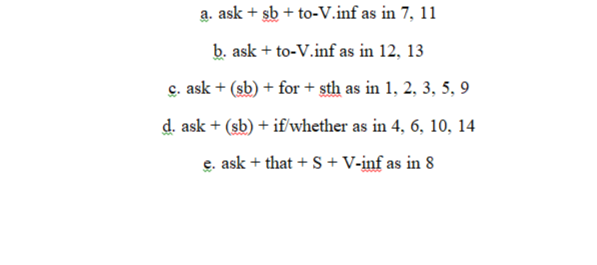
Concerning pattern d, {ask + (sb) + if/whether}, it could be comprehended to stand for requesting permission for the performance of sth (OALD, 2005, p. 75). Two specific hypothetical examples could be provided as the following (OALD, 2005, p. 75):
1: I’ll ask if it’s all right to park here.
2: She asked her boss whether she could have the day off.
3: I asked whether they could change my ticket.
4.2 BEG
1:Beg : “to ask sb for sth especially in an anxious way because you want or need it very much” (OALD, 2005, p. 125).
Corpus Data
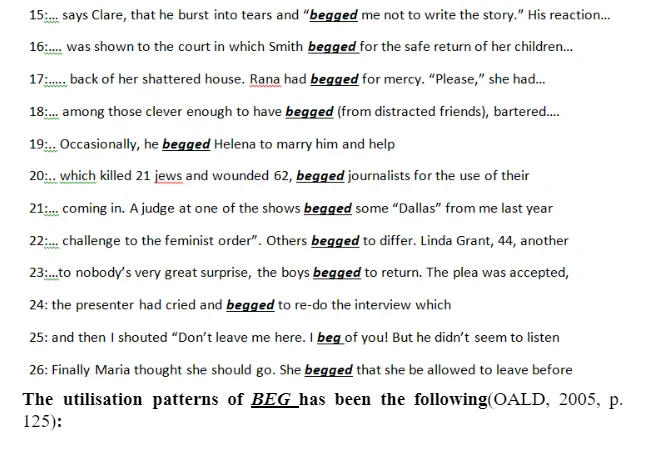
Probable patterns of BEG
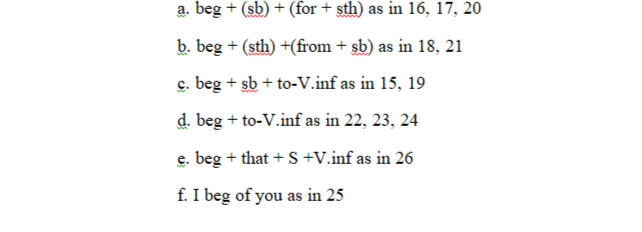
4.3 Plead
1: Plead : “to ask sb for sth in a very strong and serious way.”
The utilisation patterns of PLEAD have been the following
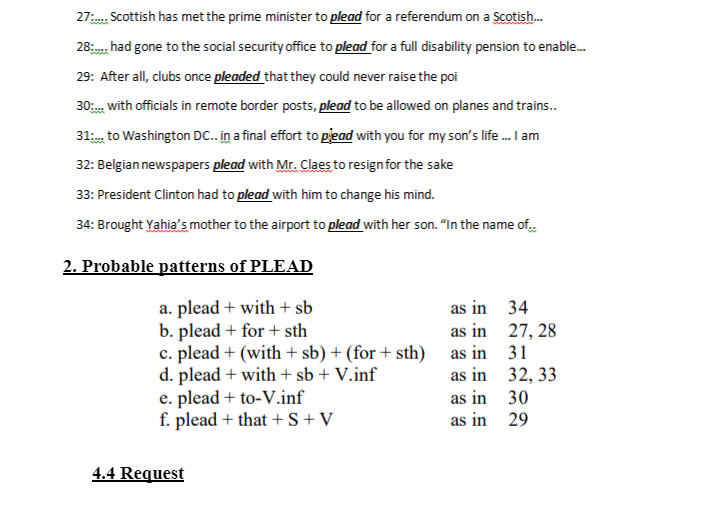
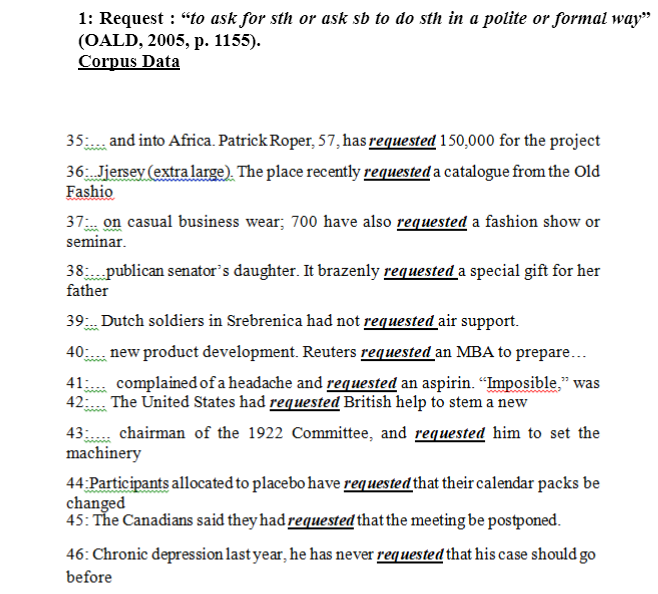
According to Caines, McCarthy and O’Keeffe (2016), the word Request could bring forth the information from evaluated concordance lines that greater grammatical patterns could become evident in comparison to the information mentioned in the three learning dictionaries under consideration. Here, the initial consideration could be the demonstrated pattern (c) in the following manner:
request + that + S + V.inf
From the evaluation of the corpus data, it could be observed that the modal (should) could be utilised at some occasions in a congruent manner to this identified pattern such as in the following pattern of (e:)
request + sth + for + sb/sth as in 35, 38
The grammatical, as well as subjunctive format of application of the identified modal could be contemplated from the above explanation. This format of application is generally acknowledged by the grammarians. A pertinent exemplary hypothetical sentence could be outlined as the following:
“…he has never requested that his case should go before..”
Concerning pattern (d), the consulted dictionaries have provided the utilisation of the word within the passive construction mode as the following:
1: They had been requested to assemble at the congregation centre (OALD, 2005, p. 1289).
2: Visitors have been requested to refrain from walking on the marble floor (CALD, 2009, p. 1210).
3: All of the club members have been requested to attend the meeting of the annual presidium (LDOCE, 2009, p. 1483).
The concordance lines have indicated that both the active and passive sentences could be construed effectively within this context. The evidence could be gathered from examples of 40, 42 and 43 regarding naturally occurring active construction within the stated patterns. Furthermore, the corpus data collection and concordance lines have detailed the pattern (e) in the following manner:
request + sth + for + sb/sth
This pattern could not be detected in any of the 3 consulted dictionaries; however, the corpus data in 35 and 38 could demonstrate this pattern.
4.5 Appeal
1. Appeal: The defining senses of meaning for the word Appeal are two in number, which are closely related. These are as the following:
1. to make a formal request to a court or to sb in authority for a judgement or a decision to be changed, (OALD, 2005, p. 60)
2: “to make a serious public request for help, money, information
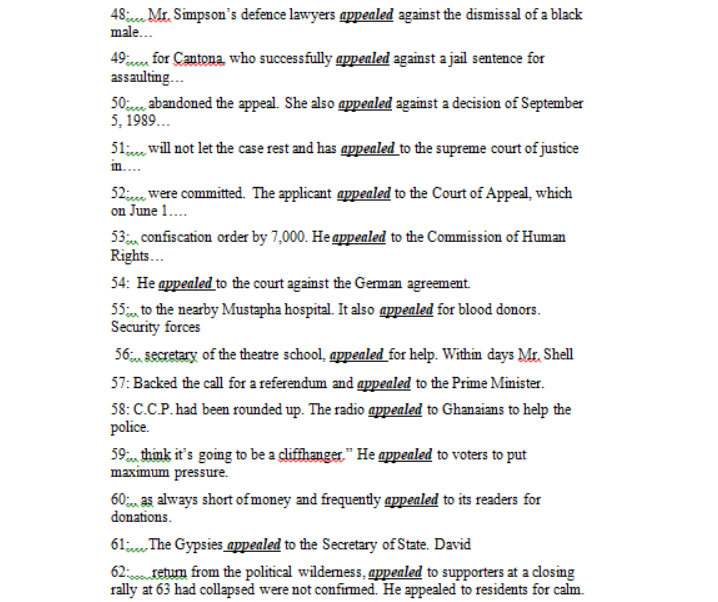
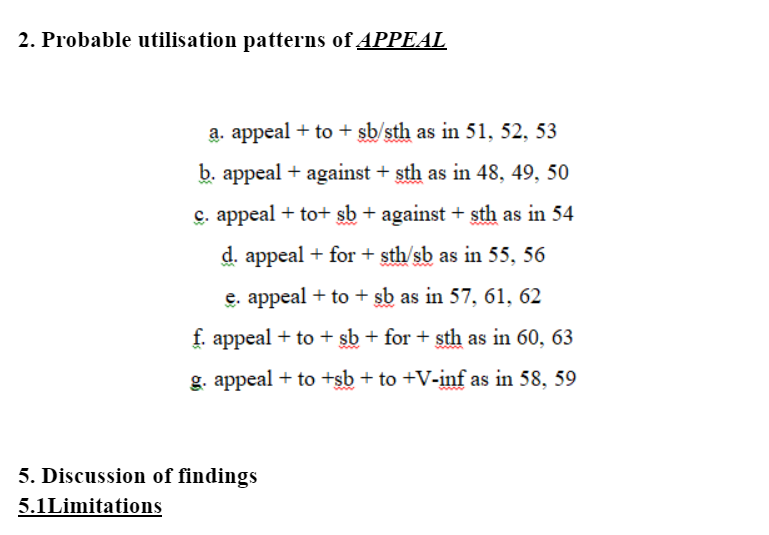
From the data demonstrated in the preceding section, it is observed that it is necessary to acknowledge that such data could only represent partially the entire reservoir of information and researches involving the linguistic corpora related to the English grammar. The information gathered could not represent every format of grammatical variation and linguistic corpus based specifics of the selected synonyms. The grammatical pattern variations are consequently much greater in number, which could naturally occur within authentic English and this is the limitation of the research of not having the scope of evaluation of a considerable larger corpus of linguistic data.
5.2 Dialects
Particular idiomatic expressions could be identified to be unique in terms of their application on a regional basis. Some grammatical patterns also have such specialities. According to Green (2017), Beg is the word which could illustrate such an observation since in informal British English, the expression “sth is going begging” has extensive application. According to CALD (2009, p. 120), this could be considered to be the fulfilment of first research objective of investigating the formality of context and stylistic suppositions associated with the selected synonyms as it denotes that no other utilisation is associated with such an expression as far as the purpose and context of such an act are concerned. One particular example is the following:
If that bottle of wine is going begging, I’ll have it. (CALD, 2009, p. 120)
In North American English based linguistic applications, utilisation of (appeal + sth + to + sb) is prevalent as the following:
“The organisation has 10 days to appeal the decision before the tribunal.” (OALD, 2005, p. 60).
Concerning the contextual style and formality, the word Request occur with greater propensity than other synonyms (Ask, Plead and Beg). The concordance lines demonstrate that Request co-occur with words denoting formality. For instance, Urine Sample (64), Adjournments (65), Anonymity (66), Gas Consumers’ Council (67), Secretary of the State (68) and Normal Tennis Attire (69).
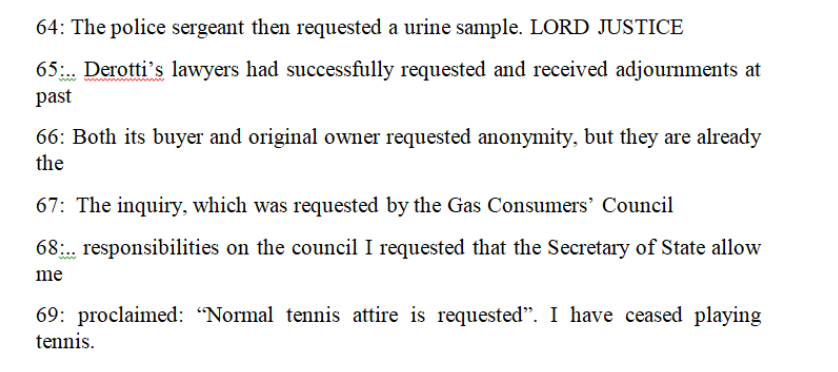
5.3 Grammatical Patterns
The grammatical patterns establish distinction in between the evaluated synonyms since each of them tend to involve particular grammatical patterns. Such words are considered as loose synonyms and thus, are not expected to replace each other. Such findings are particularly significant since these indicate to the fulfilment of the initial research objective of identification of appropriate lexical information including connotative meanings, referential implications and the collocations of the selected synonyms. The different and shared patterns of both of these words are as the following:
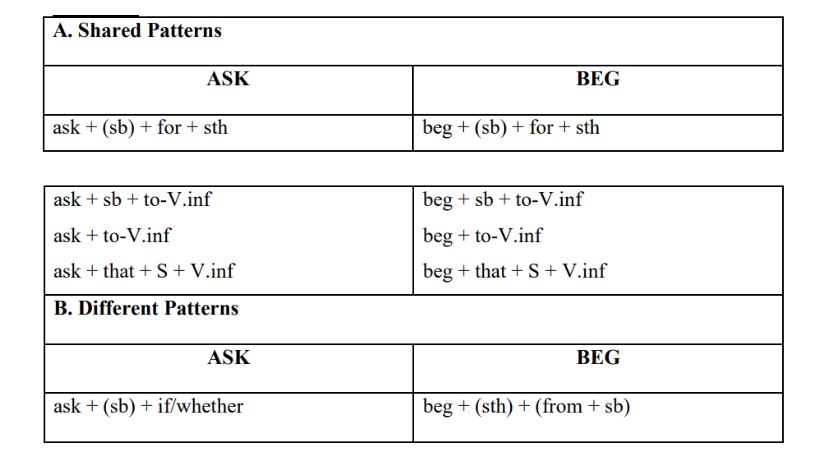
From the phraseological perspective, English learners are expected to be aware of the idiomatic expressions and lexical phrases which are constituted through the word Beg. The following are the examples:
I beg your pardon: This asks sb for repetition of concurrent statements.
I beg to differ: Registering formal disagreement with the statement of sth.
Be going begging: Denotes availability of sth to anyone.
Beg the question: The expression is utilised to denote any question which the sb could intend to ask any question which has hitherto not been asked.
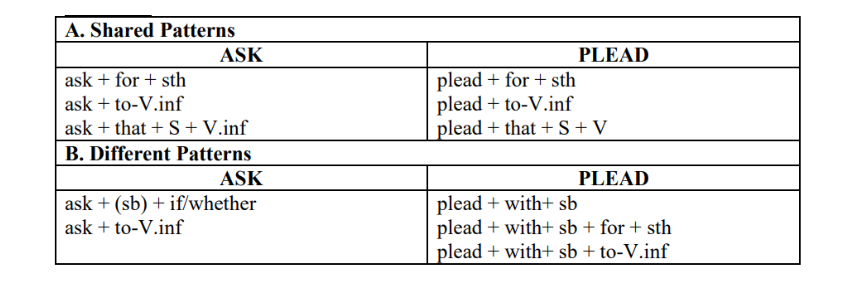
The above mentioned table has highlighted the assessment of syntactic patterns of such synonyms. This has been indicative of fulfilment of the second research objective through identification of the fact of the shared pattern constituted by ‘that clause’, the words Ask and Plead are utilised in different manners. Emplacement of ‘that clause’ after Ask requires specific subjunctive moods as the verb could be utilised in the base form. On the contrary, the verb phrase within the ‘that clause’ does not require such expressions. Carter and McCarthy (2017) have specified that modals such as Must and Could including verb forms in the simple past form could be utilised as in the following manner:
1: They pleaded that it was not possible for them to raise the money ever.
2: They pleaded that the declaration must be taken into consideration
3: He pleaded that the deals were not binding because….
The conclusive observation could state that the structure plead + that + clause generally does not facilitate a verb in the subjunctive form.
5.4 Collocations
The studied words are verbs and their primary collocations are adverbs and nouns. The collocates, identified through the corpus data and dictionary based study of the synonyms Beg and Plead are, as the following:
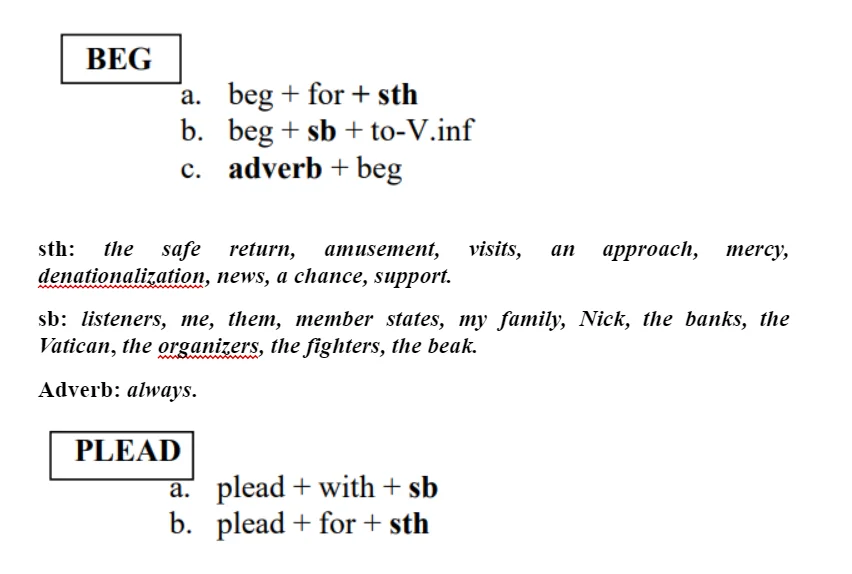
sb: you, him, them, her son, a policeman, the Office of Fair Trading, ministers etc.
sth: a referendum, one’s life, calm, funding, freedom, mercy, good behaviour, cash, greater tolerance, clemency, better treatment, one hour, more time, common sense, human decency, an international conference etc.
For the collocates identified regarding the rest of synonyms evaluated, please refer to the appendices
5.5 Comparison with other researches
The above demonstrated discussion and analysis of the five synonyms have specified that in terms of application, these words differ from each other in various particular details and sense of meaning. Such observations could be compared with the research performed by Su (2019) as it highlights that such near synonyms, in spite of having similarity in core meaning, have differential connotations, dialects, grammatical patterns and styles. Apart from this, the research performed by Green (2017) in similar contexts has provided the practical observation that majority of students of British English, the first language of whom is not English, tend to often use these synonyms in an incorrect manner.
6. Conclusion

The study has demonstrated that the synonyms Plead and Beg in the English language are flexible ones although they cannot be interchanged involving every application context. The divergences are constituted through multiple factors such as different denotations, dialectical variations, informality or formality of the context, grammatical patterns, as well as collocations. The distinguishing elements are vital in terms of enhancement of awareness levels of English students concerning the concepts of such constituents of the linguistic structure of English.
Reference List
- Aarts, B. & Smith-Dennis, E., (2018). Using corpora for English language teaching and learning. In Applying Linguistics (pp. 163-175). Routledge.
- Ameer, M.A.A., (2019). The Potentialities of Corpus Linguistics in Teaching English Grammar: Analyzing The Three Corpus Based Results reached by Biber et al.(1999) in the Longman Grammar of Spoken & Written English (LGSWE). for humanities sciences al qadisiya, 22(2), pp.67-72.
- Baker, M., Francis, G, & Tongnini-Bonelli, E. (Eds.) (1993). Text and Technology: In Honour of John Sinclaire. Amsterdam & Philadelphia: John Benjamins.
- Blackwell. Hunston, S. (2002). Corpora in applied linguistics. Cambridge: Cambridge
- Börjars, K. & Burridge, K., (2019). Introducing English grammar. Routledge.
- Caines, A., McCarthy, M. & O’Keeffe, A., (2016). Spoken language corpora and pedagogical applications. In The Routledge handbook of language learning and technology (pp. 374-387). Routledge.
- Cambridge Advanced Learner’s Dictionary (2009). Cambridge: Cambridge University Press.
- Carter, R. & McCarthy, M. (2006). Cambridge grammar of English. A comprehensive guide. Spoken and written English grammar and usage. Cambridge: Cambridge University Press.
- Carter, R. and McCarthy, M., 2017. Spoken grammar: Where are we and where are we going?. Applied linguistics, 38(1), pp.1-20.
- Crystal, D. (2007). Words words words. Oxford: Oxford University Press.
- Davies, C. (2007). Divided by a common language. Boston: Houghton Mifflin.
- Finegan, E. (2007). English: Its Structure and Use. Boston:
- Green, C., 2017. Approaches to English Clause Grammar. In Patterns and Development in the English Clause System (pp. 1-16). Springer, Singapore.
- Heinle & Heinle. Fromkin, V., Rodman, R. & Hyams, N. (2003). An Introduction to language. Boston London: Cassell.
- Jackson, H. & Amvela, E. (2000). Words, meaning, and vocabulary. Oxford: University Press.
- Kirkpatrick, A, (2007). World Englishes. Cambridge: Cambridge Longman.
- Longman dictionary of contemporary English (2009). Essex: Pearson Education Ltd.
- Master, P. (1996). Systems in English grammar: An introduction for language teachers. Fresno: Prentice Hall Regents.
- McCarthy, M., O’Keeffe, A. & Walsh, S. (2010). Vocabulary matrix. Understanding, learning, teaching. Croatia: Heinle.
- O’Keeffe, A. & Mark, G., (2017). The English Grammar Profile of learner competence: Methodology and key findings. International Journal of Corpus Linguistics, 22(4), pp.457-489.
- Oxford Advanced Learner’s Dictionary (2005). Oxford: Oxford University Press Oxford University Press.
- Partington, A. (1998). Patterns and meanings: Using corpora for English language research and teaching. Amsterdam: John Benjamins.
- Strauss, S., Feiz, P. and Xiang, X., (2018). Written Versus Spoken Grammar. The TESOL Encyclopedia of English Language Teaching, pp.1-8.
- Su, H., 2019. Is a meaning-based grammar of English possible?: Exploring English grammar from the perspectives of pattern grammar and local grammar. English Today, 35(4), pp.53-59.
- Swan, M. (2005). Practical English usage. Oxford:
- Tang, T., 2016. Discourse and Pragmatics in English Grammar Teaching. DEStech Transactions on Social Science, Education and Human Science, (hsc).
- Thomson-Heinle. Harley, H. (2006). English words: A linguistic introduction. Oxford: University Press
- Trudgill, P. (1990). The dialects of England. Oxford: Blackwell.
- Zakharova, E.A., (2016). Corpus-based studies in English grammar teaching at the advanced level. Russian Language Studies, (2), pp.41-49.
Appendices
Appendix I
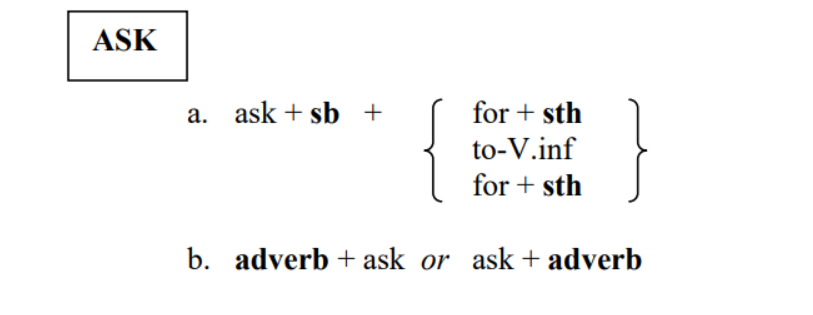
sb: people, children, the private sector, the market makers, the board, the crew, followers, the government, manufacturers
sth: help, vegetables, bread, a drink, concessions, asylum, a review, food, aid, an injection, an application form, a transfer, curriculum vitae, discounts
Adverb: repeatedly, formally, normally
Appendix II

sth: money, a fish, a stay, a performance, a gift, a fashion show, a seminar, a meeting, justice, a review, an evidence, a delay in any ruling, a urine sample, information, air support, airstrikes, an urgent report, an application form, an update, an aspirin, gas masks, privacy, an action, the return of keys, removal, supervision.
sb: shareholders, a passing waitress, her father, the authority, the Scottish Office, the police, him, journalists, Parisians, the plaintiff.
Appendix III

sth: the decision, the case, the dismissal, the order, the award, a jail sentence, convictions, the fine.
sb: the Court of Appeal, the supreme court of justice, the judges, the High Court, the House of Lords.
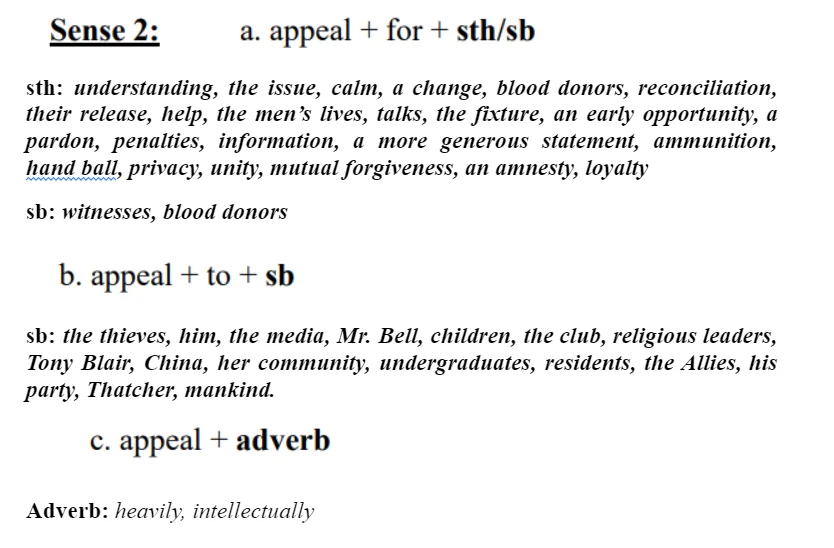
Take a deeper dive into Contemplative Approach towards Curtailing Global Warming with our additional resources.
- 24/7 Customer Support
- 100% Customer Satisfaction
- No Privacy Violation
- Quick Services
- Subject Experts



